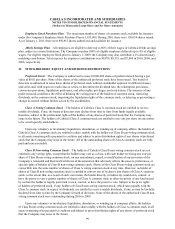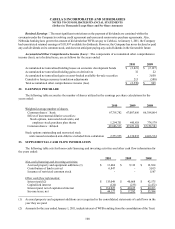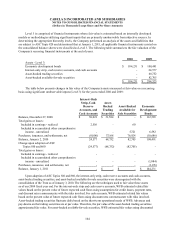Cabela's 2010 Annual Report Download - page 115
Download and view the complete annual report
Please find page 115 of the 2010 Cabela's annual report below. You can navigate through the pages in the report by either clicking on the pages listed below, or by using the keyword search tool below to find specific information within the annual report.105
CABELA’S INCORPORATED AND SUBSIDIARIES
NOTES TO CONSOLIDATED FINANCIAL STATEMENTS
(Dollars in Thousands Except Share and Per Share Amounts)
cash flow projections based upon contractual principal and interest cash flows. The discount rate utilized was based
upon management’s evaluation of current market rates; indicative pricing for such instruments; the rates from the
last date WFB considered the market for these instruments to be active and orderly, adjusted for changes in credit
spreads in accordance with ASC Section 820-10-35, Fair Value Measurements and Disclosures: Overall: Subsequent
Measurement and ASC Section 820-10-65, Fair Value Measurements and Disclosures: Overall: Transition and Open
Effective Date Information; and the discount rates used to value other retained interests in securitized loans. At the
end of fiscal year 2009, the weighted average discount rate used to value the triple-A rated notes was 1.34%, the A
rated notes was 5.16%, the triple-B rated notes was 6.56%, and the double-B rated notes was 11.00%.
Fair values of the Company’s economic development bonds were estimated using discounted cash flow
projection estimates based on available market interest rates and the estimated amounts and timing of expected
future payments to be received from municipalities under tax development zones. These fair values do not reflect any
premium or discount that could result from offering these bonds for sale or through early redemption, or any related
income tax impact. Declines in the fair value of held-to-maturity and available-for-sale economic development bonds
below cost that are deemed to be other than temporary are reflected in earnings. During 2010, 2009, and 2008, the
Company evaluated the recovery of certain bonds and determined their fair value using significant unobservable
inputs. At the end of 2010, none of the bonds with a fair value below carrying value were deemed to have other than a
temporary impairment. At the end of 2009 and 2008, the fair value of the bonds was determined to be below carrying
value, with the decline in fair value deemed to be other than temporary, resulting in fair value adjustments totaling
$8,032 and $1,280, respectively, that reduced the carrying value of the bond portfolio.
The Company evaluates the recoverability of property and equipment, land held for sale, goodwill and
intangibles on an annual basis or more frequently if indicators of impairment exist using significant unobservable
inputs. This evaluation included existing store locations and future retail store sites. The Company evaluated
the recoverability of certain property, equipment, and other assets in 2010 and recognized write-downs totaling
$3,792. The Company also recognized impairment charges totaling $1,834 in 2010, as land held for sale with a
total net carrying amount of $9,054 was written down to its fair value of $7,220. These write-downs resulted in a
total impairment charge of $5,626 reflected in earnings in 2010. Trends and management projections could change
undiscounted cash flows in future periods which could trigger possible future write downs.
In 2009, property and equipment, land held for sale, goodwill, and other intangibles with a net carrying
amount totaling $136,572 were written down to their fair value of $76,345. These write-downs resulted in a total
impairment charge of $60,227 reflected in earnings in 2009.
The carrying amounts of cash and cash equivalents, accounts receivable, restricted cash, accounts payable,
gift instruments (including credit card and loyalty rewards programs), accrued expenses, and income taxes payable
included in the consolidated balance sheets approximate fair value given the short-term nature of these financial
instruments. The secured variable funding obligations of the Trust, which include variable rates of interest that
adjust daily, can fluctuate daily based on the short-term operational needs of WFB with advances and pay downs
at par value. Therefore, the carrying value of the secured variable funding obligations of the Trust approximates
fair value. Credit card loans are originated with variable rates of interest that adjust with changing market interest
rates. Thus, the carrying value of the credit card loans less the allowance for loan losses approximates fair value.
This valuation does not include the value that relates to estimated cash flows generated from new loans over the
life of the cardholder relationship. Accordingly, the aggregate fair value of the credit card loans does not represent
the underlying value of the established cardholder relationship. Time deposits are pooled in homogeneous groups,
and the future cash flows of those groups are discounted using current market rates offered for similar products for
purposes of estimating fair value. The estimated fair value of secured long-term obligations of the Trust and long-
term debt is based on future cash flows associated with each type of debt discounted using current borrowing rates
for similar types of debt of comparable maturity.
























